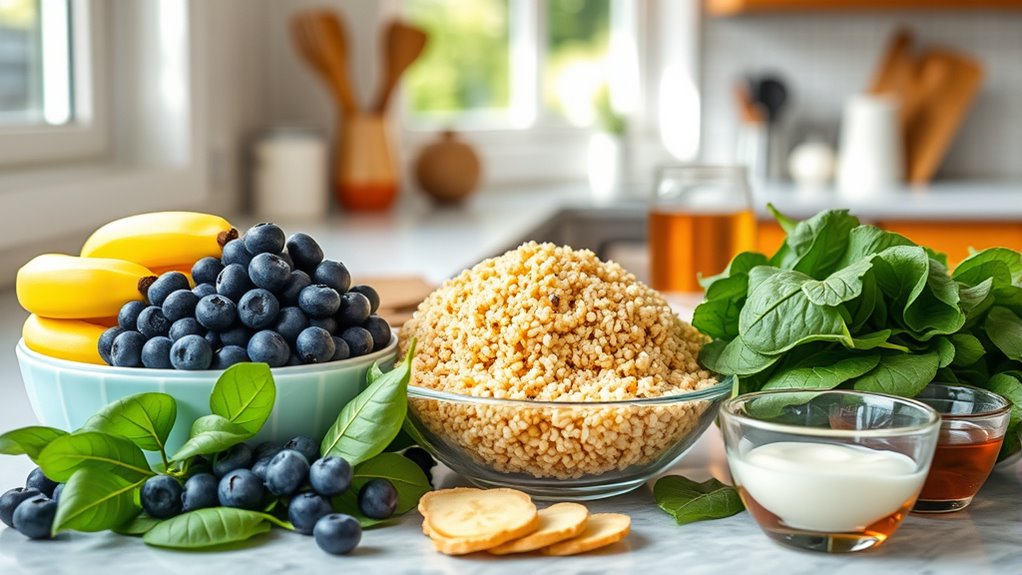To improve digestive comfort on a low-FODMAP diet, focus on planning balanced meals with low-FODMAP ingredients and flavoring them with herbs and spices like basil, oregano, or cinnamon. Keep a food and symptom diary to identify triggers, and reduce stress through relaxation techniques. Stay well-hydrated and incorporate probiotics or fermented foods to support gut health. With careful management and the right tips, you can ease symptoms and enjoy your meals—more helpful insights are ahead.
Key Takeaways
- Incorporate low-FODMAP herbs and spices to enhance flavor without triggering symptoms.
- Plan and batch cook meals with safe ingredients to maintain consistency and avoid accidental high-FODMAP intake.
- Keep a detailed food and symptom diary to identify personal triggers and adjust your diet accordingly.
- Manage stress through mindfulness and relaxation techniques to reduce gut sensitivity and discomfort.
- Stay well-hydrated to support digestion, prevent constipation, and help your gut function smoothly.
Understanding the Role of FODMAPs in Digestive Health
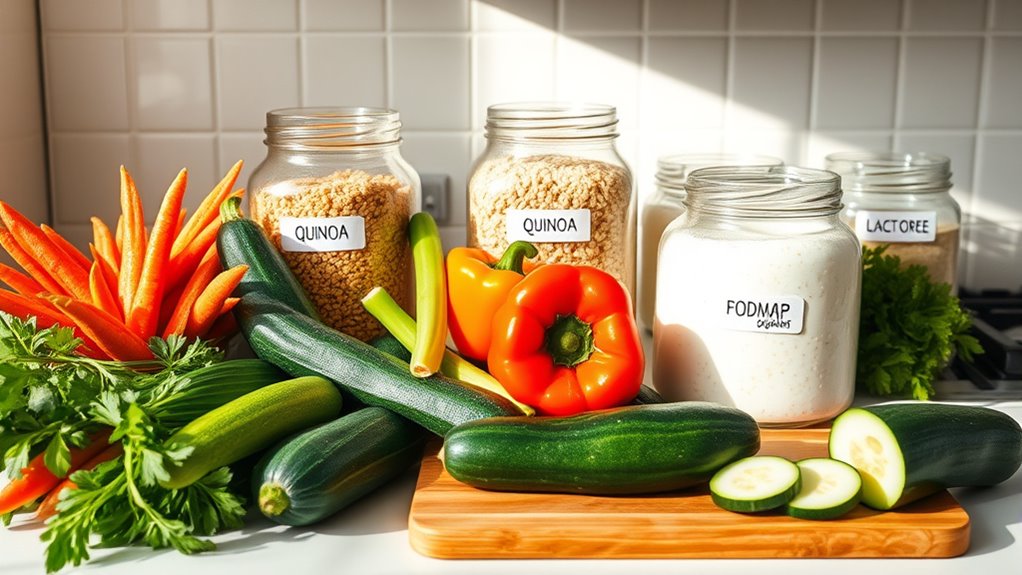
FODMAPs are fermentable short-chain carbohydrates that play a significant role in digestive health, especially for those with sensitive gastrointestinal systems. When you consume FODMAPs, they move slowly through your small intestine, attracting water through osmosis. Once they reach your large intestine, gut bacteria ferment them, producing gases like hydrogen, methane, and carbon dioxide. This fermentation causes bloating, distension, and abdominal pain, especially in people with IBS or SIBO. The osmotic effect and gas production lead to symptoms such as cramping, diarrhea, and discomfort. FODMAPs also serve as fuel for gut bacteria, influencing your microbiome composition and gut environment. Understanding how FODMAPs impact your digestion helps you recognize why certain foods trigger symptoms and guides you toward effective dietary management.
Identifying High-FODMAP Foods to Limit or Avoid
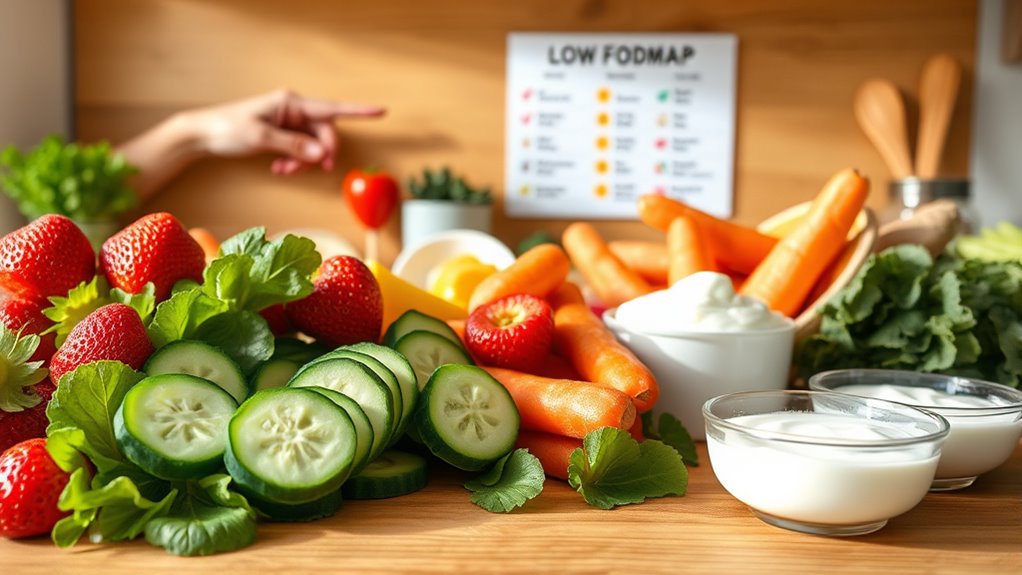
Knowing which foods are high in FODMAPs can help you manage your symptoms effectively. Common high-FODMAP fruits include apples, cherries, apricots, figs, and blackberries in large amounts. Vegetables like onions, garlic, leeks, asparagus, and beans are also high in FODMAPs, especially fructans and galactans. Grains such as rye bread, wheat bread, granary, multigrain bread, and barley contain significant fructans and should be limited. Dairy products like milk, soft cheeses with lactose, and whey are high in lactose, which can cause issues. Some protein sources, including lentils and processed meats with high FODMAP ingredients, may trigger symptoms. Additionally, sweeteners like high fructose corn syrup, sorbitol, and maltodextrin should be avoided, as they contain FODMAPs that can worsen digestive discomfort. Being aware of Vetted conversion kits and their features can help you choose reliable options if you’re considering electric bike upgrades for your lifestyle. Incorporating mindfulness techniques such as deep breathing and visualization can also help you manage digestive symptoms by promoting relaxation and reducing stress. Moreover, understanding the effectiveness of dietary adjustments can empower you to tailor your approach for better comfort and health.
Planning Balanced Low-FODMAP Meals and Snacks

Planning balanced low-FODMAP meals and snacks is key to maintaining digestive comfort while enjoying variety and nutrition. Using tools like the Monash App can help you organize meals and track FODMAP content. Dedicate time each weekend to plan your weekly menu, which makes shopping and prep easier. Batch cooking large portions saves time and ensures you always have low-FODMAP options ready. Focus on including protein, vegetables, grains, and fruits to create well-rounded meals. Incorporate lean proteins like chicken, rice, and low-FODMAP vegetables such as cucumbers and bell peppers. Snacks like fresh fruit, lactose-free yogurt, and veggie sticks provide quick, satisfying options. Proper planning reduces stress and helps you stick to your diet, supporting digestive health without sacrificing variety. Additionally, meal prep techniques can streamline your routine and help maintain consistency. Understanding payment security and the importance of secure transaction methods are essential when managing online tools for meal planning and tracking. Being aware of juice yield from citrus fruits can also help in selecting the right ingredients to balance flavor and FODMAP content in your meals.
Tips for Effective Food Reintroduction and Tolerance Testing
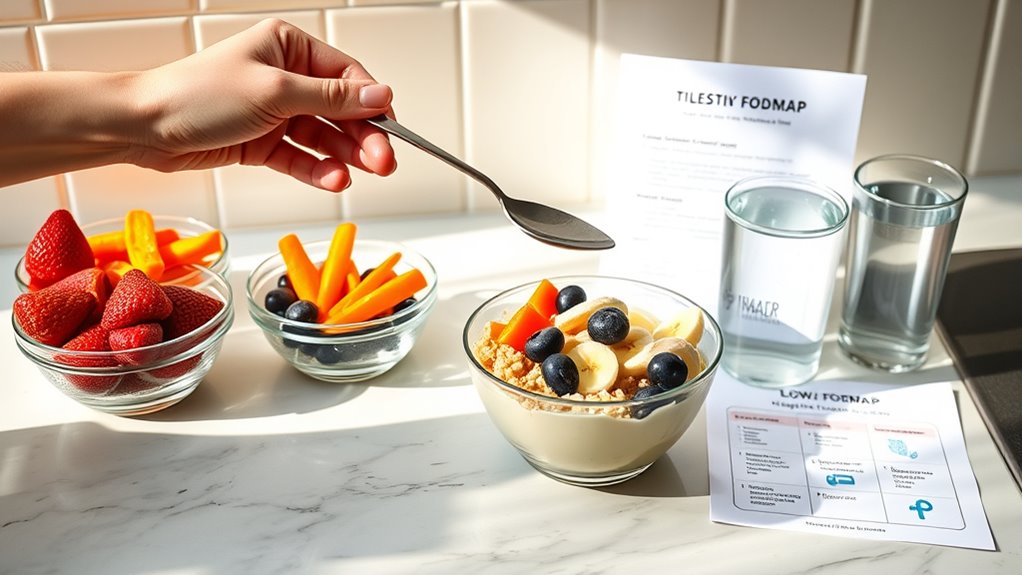
To guarantee accurate results during reintroduction, it’s important to follow a structured approach. Begin only after 2–6 weeks on a strict low-FODMAP diet when your symptoms are minimal. Keep the diet during testing days, except when trying specific FODMAPs, and ensure at least three symptom-free days before each new challenge. Avoid eating out or unknown foods to better identify triggers. Planning for 6–8 weeks to test all FODMAP groups systematically can help ensure comprehensive assessment. Test each group separately over three days, gradually increasing portions to assess tolerance. Track symptoms daily in a diary or app, noting bloating, gas, pain, and bowel habits. Spacing challenges apart and starting with small portions can help you identify your personal thresholds. Monitoring expiration dates on food packaging can help prevent accidental consumption of spoiled items that might skew test results. Being aware of FODMAP content in foods can further assist in accurate testing and avoiding unnecessary discomfort. Incorporating patient-centered care and consulting a healthcare professional can provide personalized guidance and interpretation. Additionally, understanding dietary restrictions can improve compliance and overall success of the reintroduction process. Regularly reviewing food labels can help ensure that you stick to tolerated foods and avoid accidental FODMAP intake.
Incorporating Herbs and Spices to Enhance Flavors

Incorporating herbs and spices into your low-FODMAP meals is an effective way to boost flavor without risking digestive symptoms. Certified low-FODMAP herbs like basil, oregano, parsley, rosemary, sage, thyme, tarragon, and kaffir lime leaves add fresh, vibrant notes to dishes from Italian, French, or Southeast Asian cuisines. Parsley and coriander are versatile and retain strong flavors, even in small amounts. Using fresh or dried herbs allows you to layer flavors without excess salt or fat. Spices such as cinnamon, cumin, turmeric, paprika, and chili powder provide warmth and aroma, while asafoetida mimics onion and garlic taste. Combining these herbs and spices helps make your meals exciting and satisfying while maintaining digestive comfort.
Monitoring Symptoms and Maintaining a Food Diary

Tracking your symptoms and keeping a detailed food diary are vital steps in managing a low-FODMAP diet effectively. By recording daily digestive symptoms like bloating, gas, cramping, and diarrhea, you can spot patterns linked to specific foods. Note when symptoms occur relative to meals to help identify triggers. Using symptom rating scales makes tracking more objective, while recording non-digestive symptoms like fatigue or headaches can reveal additional insights. Maintain a thorough food diary, including portion sizes, preparation methods, condiments, and any deviations from your usual eating habits. Record post-meal symptoms with onset times and severity. Incorporating juice recipes and preparation methods can help diversify your diet while monitoring your tolerance. Additionally, understanding how food processing impacts FODMAP content can assist in making better dietary choices. Being aware of pinball machine weights can also be useful if you consider home modifications or equipment handling. Regularly review your logs to detect trends, adjust your diet as needed, and personalize your plan, improving your digestive comfort over time. Keeping track of financial aspects such as expenses related to special ingredients or dietary consultations can also help manage your low-FODMAP journey effectively. Monitoring food storage practices can further ensure that cross-contamination does not occur, helping to maintain food safety and diet adherence.
Supporting Gut Health With Probiotics and Other Strategies

Supporting gut health is essential for managing digestive symptoms and promoting overall well-being, and probiotics play a key role in this process. These friendly microorganisms support digestion by crowding out harmful bacteria, reducing inflammation, and boosting immunity. Certain strains like Lactobacillus acidophilus can even lower cholesterol levels. Probiotics enhance the production of antimicrobial substances like short-chain fatty acids, which defend against harmful microbes, and improve the gut’s barrier function, preventing pathogens from entering the bloodstream. They help relieve symptoms such as diarrhea, constipation, and stomach pain, and improve bowel regularity. Combining probiotics with prebiotics—foods like onions and berries—further enhances their benefits. Maintaining a diverse, fiber-rich diet and including omega-3s supports a healthy microbiome, promoting better digestive comfort overall. Additionally, consuming fermented foods can naturally increase probiotic intake and support gut health. Research also indicates that maintaining optimal gut angles can influence digestive efficiency and overall health. Incorporating probiotic supplements can be an effective way to ensure adequate probiotic intake, especially when dietary sources are limited.
Managing Stress and Staying Hydrated for Better Digestive Comfort
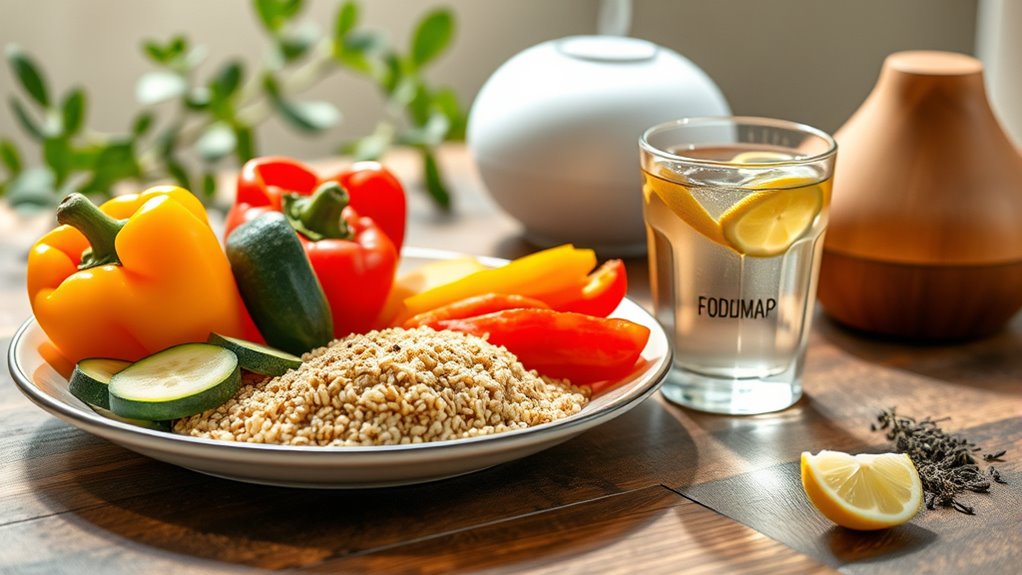
Managing stress and staying well-hydrated are key steps in maintaining digestive comfort, especially if you’re following a low-FODMAP diet. Stress activates your “fight-or-flight” response, slowing digestion, increasing stomach acid, and causing symptoms like heartburn and nausea. Chronic stress can delay stomach emptying and trigger bowel urgency or diarrhea, worsening discomfort. To manage stress, try mindfulness, deep breathing, regular exercise, or engaging in hobbies—these help relax your gut and reduce symptoms. Staying hydrated supports smooth digestion, helps dissolve nutrients, and prevents constipation by softening stools. Hydration is especially important, as dehydration can worsen stress responses and impair gut function. Incorporating stress management techniques into your routine can further enhance your comfort. Recognizing the importance of resilience can help you develop effective coping strategies during stressful times. By managing stress effectively and drinking enough water, you can promote a healthier digestive system and improve your overall comfort on a low-FODMAP diet.
Frequently Asked Questions
Can I Eat Processed or Packaged Low-Fodmap Foods Safely?
You can eat processed or packaged low-FODMAP foods safely if you choose products certified by trusted programs like Monash University. Always read ingredient labels carefully to spot hidden high-FODMAP ingredients like onion, garlic, or certain sweeteners. When in doubt, contact the manufacturer for clarification. Opt for simple, transparent labels and avoid products with ambiguous terms like “natural flavors.” This way, you can enjoy convenience foods without risking digestive discomfort.
How Do I Handle Eating Out While on the Low-Fodmap Diet?
When eating out on a low-FODMAP diet, you should research menus online, call ahead to ask about ingredients, and choose restaurants with customizable options. Focus on simple, safe proteins and sides like rice or steamed vegetables. Communicate your needs clearly to staff, avoid high-FODMAP ingredients like garlic and onion, and consider eating a low-FODMAP snack beforehand. This way, you can enjoy your meal while keeping symptoms at bay.
Are There Any Supplements Recommended During the Elimination Phase?
Imagine feeling confident during your elimination phase, knowing you’re covering all your nutrient bases. During this time, multivitamins can be helpful, especially if food restrictions limit your intake. Choose a supplement free of high-FODMAP ingredients to avoid triggering symptoms. This way, you support your overall health without compromising your digestive goals. Remember, supplements aren’t a replacement for food but a short-term safety net as you navigate your low-FODMAP journey.
How Long Should I Stay on the Elimination Phase Before Reintroduction?
You’re wondering how long to stay in the elimination phase before reintroducing foods. You should follow a 2-6 week period, with at least 2 weeks to assess your symptoms and up to 6 weeks if needed, especially in SIBO cases. Keep track of your symptoms, and consult your dietitian to decide the right timing. Once your symptoms improve, gradual reintroduction can begin, avoiding overlap until you’re ready.
Can the Low-Fodmap Diet Help With Non-Gi Symptoms Like Fatigue?
You might find that a low-FODMAP diet can help with non-GI symptoms like fatigue. By reducing FODMAPs, you can decrease gut fermentation and discomfort, which may boost your energy and overall mood. Many people report feeling more essential and less tired when gastrointestinal symptoms improve. While research is ongoing, it’s worth trying the diet under guidance to see if it helps you feel more energized and better overall.
Conclusion
Just like a skilled captain navigates choppy waters, you can steer your digestion toward smoother sailing by sticking to low-FODMAP choices and listening to your body’s signals. Remember, it’s a journey—think of it as charting your own map to comfort. With patience, mindful eating, and a bit of perseverance, you’ll find your way to calmer, happier gut days. Trust the process, and soon you’ll be the master of your digestive voyage.
